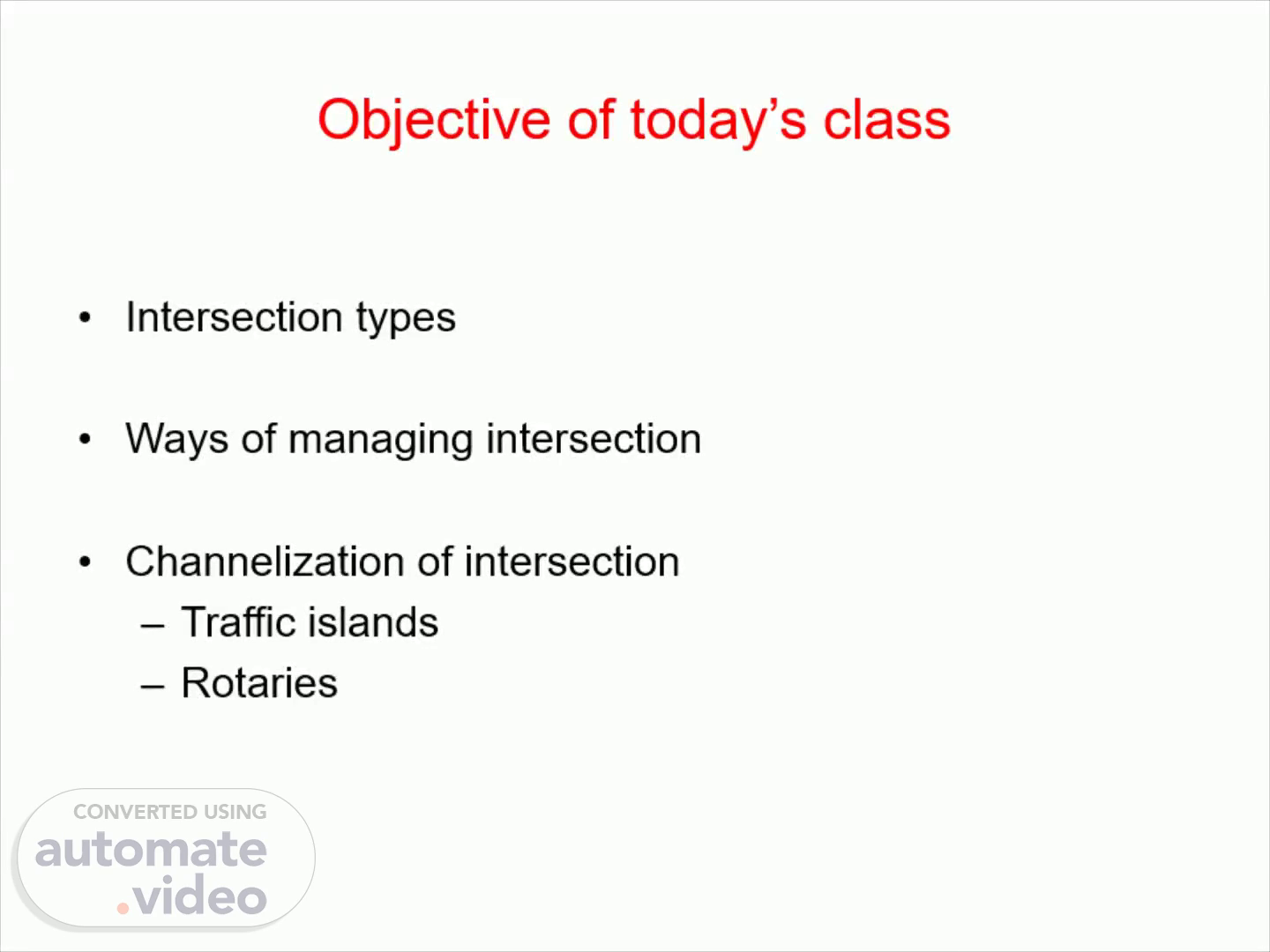
Page 1 (0s)
Objective of today’s class. Intersection types Ways of managing intersection Channelization of intersection Traffic islands Rotaries.
Page 2 (30s)
Intersection. Intersection – formed when roads carrying traffic in different directions cross each other Different flows in different direction Leads to conflict points Reduction in speed - more delay, capacity – less efficiency The basic idea behind intersection design is to modify these conflicts. Intersections should be designed efficiently – safety, capacity, cost of operation.
Page 3 (2m 16s)
CONFLICT POINTS AT AN AT GRADE INTERSECTION. Crossing Conflicts ……..16 Merging ……… 8 Diverging ……. 8.
Page 4 (4m 55s)
Two types of intersections. Intersection at grade Roads meet at same level Merging , diverging and crossing of vehicles occur They can be un-channelized, channelized, rotary intersection, signalized intersection Grade separated intersection Roads meet at different level – eliminate maximum crossing points – done by flyover or under-pass Suitable interchange facilities should be provided between grade separated roads.
Page 5 (8m 46s)
Grade Separation and Interchanges. Diamond Interchange.
Page 6 (9m 24s)
Ways to deal with at grade intersections. Channelization of traffic at intersections – provide traffic islands Provide rotaries at intersections Provide signals at intersections Combinations of above methods Island and signal.
Page 7 (10m 18s)
Channelized intersections. Intersection having Traffic islands Advantages corresponding to un-channelized intersection Reduce the total conflict area in un-channelized intersection Reduces angle of merging streams- reduce conflict impact Reduces speed of vehicles.
Page 8 (11m 37s)
•SOO.
Page 9 (13m 28s)
AREA MAJOR CONFLICT CHANNELIZING ISLAND AREA 04ANNE1 M ANDS.
Page 10 (14m 31s)
Rotary intersection (IRC 65). An intersection having large central island called rotary Advantages corresponding to un-channelized intersection Whole traffic is given priority instead of individual traffic Traffic proceeds at uniform speed Collision of through and right-turn movements are converted Milder conflicts namely merging and diverging Good for intersections having five or more approaches.
Page 11 (16m 24s)
Disadvantages As flow increases weaving becomes stop and go low traffic, the vehicles are forced to reduce speed Not suitable for acute angle of intersection Rotaries require large area of relatively flat land Pedestrians and cycles high –signals may be required Right turning vehicles have to travel longer.
Page 12 (18m 10s)
Condition for justification of a traffic rotary Volume of traffic taken together in all roads leading to rotary should be between 500 vehicle per hour to 3000 vehicles per hour (IRC norm) T raffic entering all approaches are relatively equal Number of approaches: 5 or more Proportion of right turning traffic more Insufficient space for queue formation at approaches.
Page 13 (19m 26s)
Rotary design - Steps. Check whether a rotary is justified based on criteria given Decide the shape of rotary Design the parameters.
Page 14 (20m 16s)
Shape of rotary (IRC 65). Circular shaped. Squarish rotary with rounded edge.
Page 15 (21m 25s)
Rectangular shape. Elliptical rotary. Complex rotary intersection.
Page 16 (21m 53s)
exit radiu entry radius entry wi dth exit radius of the central island weaving wi dth circulation wi dth wi dth approach width.
Page 17 (26m 53s)
Design factors for rotary. Design speed Usually assumed as 30 Km/ hr or 40 Km/ hr (IRC 65) Radius at entry decided based on design speed -25m for 30km/ hr and 35m for 40km/ hr (refer IRC 65) Radius at exit -2 times entry radius Radius of central island:1.33 times the radius of entry curve Width of carriageway at entry and exit (IRC -65, Table 2 ) Width of non-weaving section – width of widest entry section Width of rotary roadway (m) (Weaving width for each section) The width of the weaving section should be higher than the width at entry (e1)and circulation width(width of non-weaving section) (e2). Thus weaving width is given as,.
Page 18 (29m 49s)
Width of rotary carriageway.
Page 19 (30m 19s)
Weaving length = 4 x width of weaving section (m) Capacity of rotary –minimum capacity of individual weaving sections where ’w’ is the is the weaving width (m) ‘e’ average entry and exit width, ((e 1 +e 2 )/2)) , ’l’ is the length of weaving (m) ’p’ is the proportion of weaving traffic to the total traffic at a stretch (weaving length)..
Page 20 (31m 43s)
$\displaystyle p=\frac$. ‘a’ and ’d’ are the non-weaving traffic, and ’b’ and ’c’ are the weaving traffic.